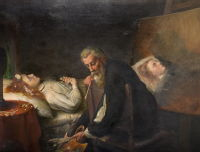Family Values
Cultural production in early modern Italy was intimately tied to neighbourhood, friendship and extended kinship ties. The family in particular was a key component of identity but as the historian Thomas Kuehn observed some years ago, the family was not just a ‘genetically constituted, co-residential unit of production and consumption. It was a group with practical interests that were mediated by cultural logic’. Whilst studies of patronage have shed much light on the dynastic relationships of artistic patrons and agents, particularly through the work of Haskell, Bourdua and others, much work remains to be done on the makers’ families. In his groundbreaking study of 1938, Martin Wackernagel briefly drew attention to this phenomenon, but there is as yet no systematic or extended study.
Recent archival discoveries suggest that artistic dynasties dominated production of both large- and smaller-scale works of art ranging from painting and sculpture, to decorative objects such as bronze statuettes and glassware and functional objects such as steeple bells and artillery. This proposal will consider and debate the following issues:
(1) the role of fathers and sons in artistic production, including both biological and adopted children, for the latter became a practical solution for childless masters or those with sons lacking talent and/or volition, as in the well known case of the painters Squarcione and Mantegna;
(2) the importance of marriage and the role of women in artistic families in particular the position of daughters in the workshop as potential artistic successor (such as Lavinia Fontana or the Castelli sisters, bell founders), or as spouse for the talented apprentice;
(3) the role and extent of the ‘extended’ family, such as uncles, cousins, sons/brothers-in-law and when should we consider such workshops ‘independent’ (the case of Giovanni Bellini and Andrea Mantegna comes to mind);
(4) the impact of death, family conflict or break-up in artistic production;
(5) the impact of family workshops on artistic style and form over the longue durée from the fourteenth to the eighteenth century.
Warwick’s presence in the English Midlands and the Veneto offered us the added opportunity of studying the Italian early modern workshop in two contexts: England and Italy. Thus, the first two-day workshop (a) was led by Victoria Avery¹ and Louise Bourdua² and took participants to Warwick and London. We focused on the artistic production of two Italian sculptural workshops that worked for the English crown, those of Pietro Torrigiani (1472-1528) and Francesco Fanelli (1590-1653), and compared them with contemporary English workshops based in Warwickshire who learned much from their Italian counterparts. Classroom-based sessions introduced participants to the archival documentation pertaining to Italian artists in England.
The second workshop (b) and summer school (c) were located in the Palazzo Pesaro Papafava, Warwick-in-Venice’s base in this city. Seminar papers by visiting speakers and Warwick/Consortium faculty were invited on the topic of family relationships within the Italian artistic workshop and the pre-eminence this had over other arrangements. A key part of the Venice-based activities took the form of workshops and daily guided visits for doctoral students and post-doctoral fellows to key sites including extant artistic workshops and artisans/architects’ homes. Time was also spent exploring the city’s wealth of pertinent archival material. The former site visits enabled examination of the spatial environment of some of the key artistic families in Venice, while the latter equipped participants with valuable investigative tools for current and future research.

Emily Price - Fellowship report
Megan Moran - Fellowship report
Photos from Venice Summer School, July 2010
